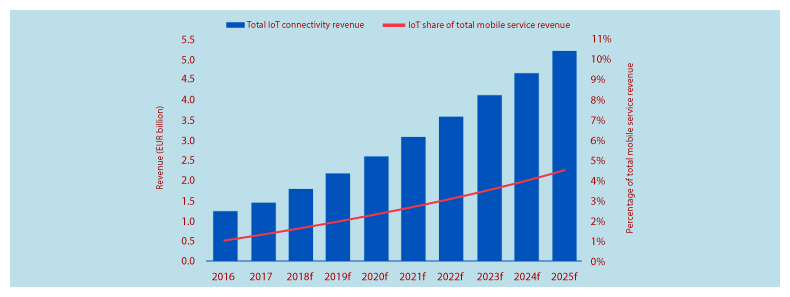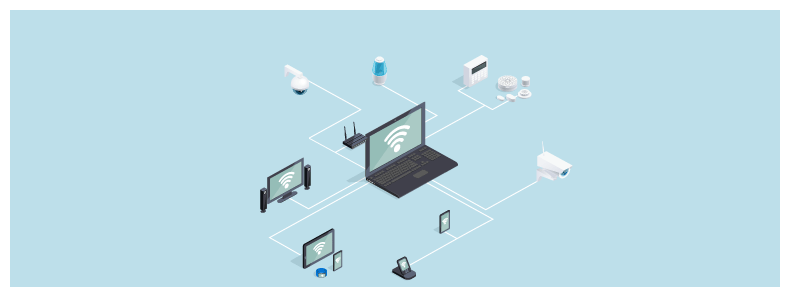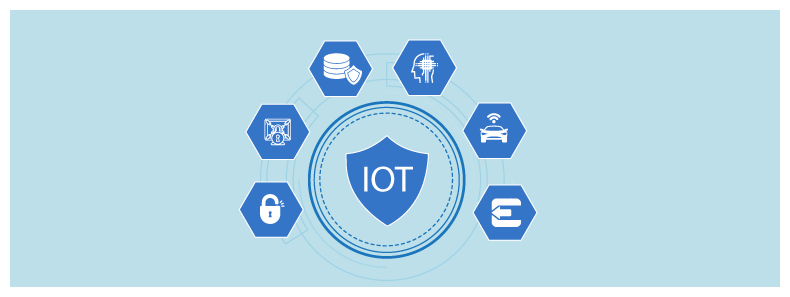Major Challenges in IoT Application Security
Have you ever switched on the light or your air conditioner with your smartphone? Or have you ever experienced the wonders of a VR box with a motion sensor? What about your fitness band or smartwatch or application security like biometric machines? All these conveniences in our daily lives are the gift of IoT.
IoT or the Internet of things is an intricate system that is interrelated to digital, mechanical, and computing devices via unique identifiers. Simply put, it is the process that takes all the technical things which can be internet-linked, and connect them directly to the internet.
No, your old kettle or laundry machine does not count. But if you purchase the IoT-enabled versions, you can enjoy its benefits like automatic shut-off, smart indicators, etc. In today’s day and age, you will find most of the devices to be IoT-enabled. It can be as simple as a Bluetooth-enabled toy/drone or as complex as fingerprint technology to unlock an app or entering biometric credentials. On a larger scale, you can find the contribution of IoT via offices with sensors or even smart cities.
Statistics on IoT

- By 2030, 75% of all devices are predicted to be IoT.
- As per a report presented by Transforma Insights, the assumed IoT revenue market will reach nearly $1.5 trillion by 2030, on a global level.
- Another report published in Statista also projected the forecast of $1.1 Trillion global spendings by the end of 2023.
- This will not only cover the Industrial and Commercial electronics segments but has roped in the USA’s smart home control and connectivity segment, whose assumed monetary involvement will cross $30 billion.
- The healthcare market has also come under the roof of IoT and by 2024 (globally), its revenue would reach around $14 billion.
- The automotive industry has already invested more than $100 billion and the predictable percentage of IoT-enabled automobiles will be around 70% by 2023.
What is IoT security?
The method of safeguarding IoT networks and devices from the open internet they are connected to is known as IoT security. Focusing on the business settings, Internet of Things devices encompasses:

- Laptops
- Tablets
- Smartphones
- Automation technologies
- Smart energy grids
- Industrial machines
- Biometric machines
- Internet-enabled Vending machines
- Smart Sensors
As the stakes with IoT security are higher, the consensus is even lower for security implementation. The developments and innovations related to IoT have become global with a widespread impact. It does not have the same reservations of smart security systems or industrial applications as what businesses had 10 years ago.
- The modern-day engineering industry is more focused on creating IoT applications and solutions.
- Added to this, the logistics and manufacturing units are blindly reliant on GPS and RFID technology for seamless industrial operations.
- If policyholders invest in new financial plans or become loyal members, they are gifted attractive-looking wearables.
- Even Google Home and Alexa have become the personal assistant of most of the consumers.
It is amazing how IoT has seeped into the lives of common people, making them feel future-ready, yet often throwing them off guard with myriads of security challenges.
Challenges in IoT Application Security
The market size of IoT application security has grown considerably with time. As per the last report with Europe as the targeted continent, IoT has expanded its revenue root from primarily the consumer segment, estimated to be around €28.5 billion in 2019. When IoT devices are created, they are designed with the requirement of demand fulfillment and not application security purposes.

And now, the result stands to be several security issues that have become challenges for cybersecurity agents.
1. Brute force
Weak login details and credentials are the two challenging aspects that act as a vulnerability to brute forcing and password hacking.
One of the best examples to explain this challenge is the Mirai botnet. They have utilized highly disruptive DDoS attacks. What they never did when sending the IoT devices to the customers was intimate them to change the given password with a new one.
This action created a hubbub, and currently, the action has become a warning guideline to tackle the dangerous practice.
It is a fact that around 50% of credentials are simply hardcoded directly into Mirai variants’ source code. If you search for it on the internet, you can easily get one. These credentials are generic and can be like:
- root: root
- root:1234
- admin: admin
Moreover, 27% of the attacks were the outcome of such generic groups.
One of the best ways this situation can be tackled is by the usage of Security Information and Event Management. It could execute scripts that can rule in the Web Application Firewall (WAF) and stop the brute force attacks.
2. Ransomware
If you think that IoT ransomware is a serious threat, you are correct. However, you may not be able to guess its intensity. With smart devices connected to the internet, the number of ransomware and malware exploits has increased considerably.
A hacker with ransomware can lock you out of your device or home (if you live in a smart home) and only consents to give access in exchange for a heavy ransom.
3. Data Privacy and Security
Cloud, web, mobile – aren’t these basics things that you use the most? Well, of course!
All of these things are what connect you to the outside world. Yet, data security and privacy are collaboratively the single biggest issue regarding the internet interconnected world. Large establishment us an array of IoT devices for data:
- Processing
- Storing
- Transmission
- Harnessing
The devices that are most in use and are sold includes:
- Smart thermostats
- HVAC systems
- Connected Printers
- Lighting Systems
- Speakers
- Smart TVs
When using these devices, you submit your data (apps, entertainment portals, job portals, ticket purchase). The user data is sold or shared amongst companies. In fact, your website is also not safe.
If you have a business website, you should safeguard it with WAF. It is an application security firewall that can protect your web applications by monitoring, filtering, and blocking malicious traffic traveling HTTP/S.
4. Artificial Intelligence
From face recognition in your smartphones to Siri or Alexa, AI and IoT are an inseparable asset from human lives in today’s world. Even for small to huge financial transactions, you are dependent on IoT services.
If you look from the perspective of networking and data collection, a huge amount of data can be difficult to manage. To sift through the huge data amount, detect anomalous traffic and data patterns, and enforce data-specific rules, network security officers and IoT administrators use automation and AI tools. This autonomous decision can cause a misbehaving algorithm and error codes and can affect multiple infrastructure platforms like:
- Healthcare
- Transportation
- Power
This can make the apps weak and prone to theft or cyber-attacks.
5. Remote vehicle access
In addition to hackers taking control of your smart homes, they can also hijack your smart vehicle. Although in progress, Toyota was on the verge of showcasing its brilliant smart, self-automated car in 2020’s Tokyo Motor Show.
These cars are designed with interconnected IoT devices and are under the risk zone of skilled hackers. You can easily envision if an IoT-connected car of yours gets hacked and gets used in lethal crimes, in what position would you stand?
6. No security for minor evasions
The year 2017 saw the emergence of the IoT-based botnet, which was more dangerous than the Mirai botnet – the Reaper. Similar to this IoT-based botnet, it is predicted that more micro-breaches can skip through the existing security net and create chaos.
If such a thing persists, there wouldn’t be the requirement of physical assault or the use of big ammunition. A small information leak or ransomware is enough to create a conundrum.
7. API Security
IoT applications heavily rely on APIs for communication between devices, services, and platforms. API security is a critical aspect often overlooked. Issues include:
Authentication and Authorization: Weak authentication mechanisms can lead to unauthorized access. Implement strong authentication methods like OAuth or API keys and enforce proper authorization to restrict access based on roles and permissions.
Data Encryption: Ensure that data transmitted via APIs, especially sensitive information, is encrypted. Use protocols like HTTPS to secure data in transit.
API Rate Limiting: Implement rate limiting to prevent abuse or denial-of-service attacks. This can help control the number of requests from a single source within a specific timeframe.
API Monitoring and Logging: Regularly monitor API usage for unusual patterns or suspicious activities. Logging API activities can provide valuable insights for detecting and responding to security incidents.
Conclusion: Securing the IoT Journey
As we immerse ourselves in the IoT revolution, prioritizing the security of both devices and the controlling applications is paramount. IoT app developers must diligently apply secure coding principles to mitigate potential vulnerabilities.
Even for organizations not directly involved in IoT app development, the expanding role of web applications and APIs in IoT interactions necessitates a robust approach to application security.
Consider scenarios where clients interacting with your web application are not humans but IoT devices, performing tasks like placing voice-controlled eCommerce orders or checking schedules and inventory.
Regardless of whether your organization plans to venture into IoT app development, it’s crucial to recognize that web applications will likely play a role in IoT ecosystems from the client side. Implementing effective application security measures prepares your organization for secure scaling as IoT adoption becomes widespread.
Adopting healthy cybersecurity practices is essential. Utilize tools like Web Application Firewalls (WAF), adhere to standards such as TLS for secure communication, and implement transport encryption. Avoid storing confidential details on your system, and if necessary, employ antivirus and cybersecurity measures.
Regularly conduct checks for malware infections and assess the reputation of your web application to maintain a secure online environment. By embracing these practices, organizations can fortify their defenses against potential IoT-related threats, ensuring a resilient and secure digital infrastructure. – generate proper heading for this details
Stay tuned for more relevant and interesting security articles. Follow Indusface on Facebook, Twitter, and LinkedIn.


 June 16, 2020
June 16, 2020






